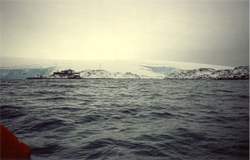
Palmer Station is located on the southwest corner of Anvers Island off of the Antarctic Peninsula. For many years it has been a popular tourist attraction for cruise ships, much to the dismay of the scientists who dislike the interruptions and disturbances. Occasionally things get a bit more disruptive. Shortly after one such ship visit, and not too far from where I took this picture, the Argentine Navy vessel Bahia Paraiso hit an uncharted shoal (the area was marked on British Admiralty charts available at the station, but the Captain was of course using Argentine charts) on 28 January 1989. This disaster deposited 300+ tourists and crew at what normally is a smaller station than Pole. The engine order telegraph and a few other artifacts eventually got deposited at the station bar. But more seriously, fuel oil and other debris became deposited on the local islands. Not exactly as serious as the Exxon Valdez disaster which occurred only a few months later, but it seriously upset long-term studies of bird and sea life on the sanctuary islands nearby.
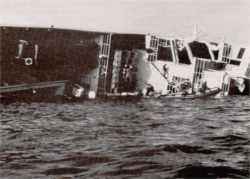
When the 430-foot vessel initially hit a rock about 2 miles from Palmer, a 30' gash was torn in the hull below the waterline. All power was soon lost, and the rescue efforts proceeded. The vessel carried an estimated 250,000 gallons of petroleum products which immediately started to become evident on the surface of Arthur Harbor. Several days later the vessel floated free and drifted closer to Palmer before running aground near DeLaca Island and capsizing as shown in the picture at right. The fuel spill spread to an estimated 6-mile radius. On 6 February the Chilean tender Yelcho started placing containment booms; a US cleanup team arrived the next day, and international efforts were underway to plug leaks in the fuel tanks, skim oil from the sea surface, and remove fuel from the ship. This would continue for the next 2 months, and another salvage effort in January 1993 removed most of the remaining oil from the wreck. While much of the spilled fuel was dissipated by natural actions, a significant impact on wildlife population was observed. Long-term studies have continued; for example, a significant decline in the local cormorant population, attributed to the oil spill, continues to this day. (NSF photo by Ted DeLaca, Antarctic Journal 6/89)
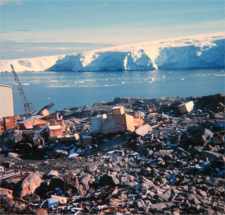
By the time of my first visits to Palmer Station in the mid-80's, the station environmental practices were "ahead" of McMurdo. Due to the location and association with marine studies, practices here conformed more closely to those of the maritime community. This was not always the case; during the initial construction of the permanent station on Gamage Point, construction debris and other trash littered the "backyard" as seen here (GWR is under construction at left) late in the 1969-69 season. It took a few years to get all of this cleaned up. (NOAA photo)
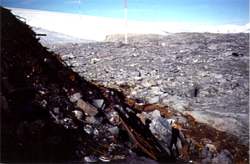
During my first visits to Palmer in 1986-87 one of the features of Saturday afternoon house mouse (weather permitting) was burning the burnables. The picture at right shows old trash and ash on the back side of the helo pad at Palmer. In 1986 the station separated all trash. During "mash and grind" the glass was crushed into 55 gal drums, and metals were crushed in an industrial strength trash compactor. All of these nonburnables were disposed of at sea north of 60°S as was the normal maritime practice. Burnables including plastics were incinerated on the helo pad. What you see here is mostly old trash left over from the days when the waste segregation was less accurate. The open burning was discontinued in 1988, and all wastes including plastics are removed from the Antarctic treaty area for disposal in Chile or the US. Since I was last on site all of the old dumps have been cleaned up, this effort finished in the 2003-04 season (here's the page of photos on the Palmer site).
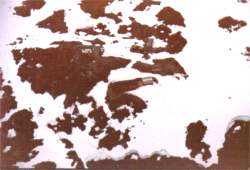
"Old Palmer" from the air, as it looked in 1988. This slide was copied from one of the infrequent Twin Otter flight crews--these craft considered our glacier to be a runway! This was the original station, constructed in 1965. The site for the permanent station a couple of miles south of here, across Arthur Harbor on Bonaparte Point, was chosen because it offered more convenient access to the water and a site for a pier. This station was constructed of the same "T5" building panels that were used to build the other original IGY stations including Pole and McMurdo. It remained until the early 1990's when NSF opted to remove it and restore the area. Behind the station to the right is the diesel fuel bladder which sat out in the weather for many years. On a sunny day it was a pleasant "mattress" to relax upon. It also was a significant environmental hazard to the "tundra" vegetation and the penguins that might decide to peck a hole in it. Have another better look at Old Palmer...
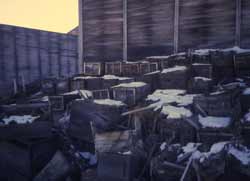
This March 1990 picture shows boxes of food and supplies stacked up behind the west wall of the main building of East Base. This was originally constructed by the US Antarctic Service Expedition of 1939-41, led by Richard Black and Finn Ronne. The location is Stonington Island, in Marguerite Bay near the base of the Antarctic Peninsula (68°S 67°E). This was intended to be a permanent station, but preparations for World War II intervened, and since the bay ice didn't break out, the station population was evacuated by air, leaving their dogs behind to be killed by time bombs after it was certain they would no longer be needed. These structures were occupied again by Finn Ronne's private expedition in 1947-48, and meanwhile the British constructed FIDS (BAS) Base E on the other side of the island. This base was occupied intermittently until 1976.
The current environmental philosophy is that stations and artifacts from before WWII are "historical" and should be preserved, and that postwar facilities should be removed and cleaned up. What about this stuff? It obviously isn't faring as well as the boxes inside the Ross Island historical huts. Based on our survey, NSF made several additional trips to East Base in the early 1990's to stabilize and conserve the place.
The building you see was half full of ice which contained frozen dead seals left over from a dog food cache. The British Base E was in much better condition than these old buildings. It was relatively weathertight and contained a cache of new and old food supplies. I was impressed by the Wheaties box featuring the 1976 Olympics!